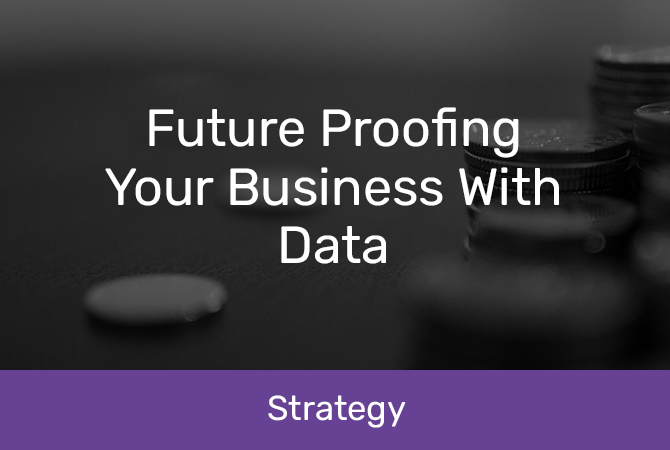
Future Proofing Your Business With Data
How to protect yourself against the coming recession
It’s easy to focus on the present when you’re running a business – operations, staff management, inventory and marketing aren’t going to handle themselves. But that could be a fatal mistake. Future-proofing your business means setting yourself up with the tools to ride out challenges and downturns. Best of all, it can help you avoid making rushed, under-informed decisions in crisis mode.
With an economic crash looking more and more likely – McKinsey reports that 81% of business leaders predict a recession in 2023 – it’s important to get those plans in place now. And it starts with data. Helping you boost revenue, cut costs, and inform decision-making, data and analytics are essential tools in your future-proofing kit. According to a recent Forbes study, 83% of execs say they’re using data to gain a competitive advantage. When things go south, that advantage could be crucial.
what's data got to do with it?
The right data and analytics tools can transform how you manage your business and help you build resilience simultaneously. In a recession, your audience and sales opportunities can shrink, so it’s essential to bolster profitability while reducing costs. This can mean streamlining operations, growing your understanding of your audience, optimising your marketing, and looking for new revenue streams. Even better, data can help you predict future outcomes and make strategic decisions based on that information. The more you know, the better you can do.
Don’t take our word for it. Businesses that use big data see an increase of 8-10% in profits, with a corresponding 10% reduction in costs. In a recession, those numbers could be the difference between staying afloat and going under.
Here’s how data can help you get future-proof:
 keep costs down
keep costs down
While it’s always wise to keep costs down, an imminent recession calls for even stricter savings and cuts. The more you can save, the bigger cash cushion you’ll have to help you through a slump. Of course, any cuts need to be carefully considered. Things like reducing the quality of your product or cutting staff could have negative impacts that counteract any cost-cutting benefits.
evaluate spending
Where does the money go? Use your data around inventory, staffing, rent, hardware, software, advertising and other costs to work out your most significant expenses. From there, you can look for ways to cut back or switch to cheaper alternatives. For example, renting a large office space in a central area may no longer make sense for your business, especially if more staff work from home. Could you shift to a smaller space or a less-desirable suburb? Are you letting subs for under-used SaaS services just roll over?
automation and time savings
Automation can be a major money saver, reducing staffing needs and accelerating service delivery. Marketing automation, for example, lets you reduce repetitive manual tasks – like email delivery – freeing time for your marketing team. Similarly, you can automate elements of your delivery or ordering systems, saving time and reducing expensive errors. Just be careful that you’re not taking a set-and-forget approach – you need to check your automation strategies regularly to make sure they’re delivering.
stronger inventory control
Inventory often represents a significant cost to your business, particularly if you tend to overbuy and end up with large volumes of unsold product sitting in storage. Data can help you regain control over your inventory and reduce running costs. Instead of large amounts of product, aim for ‘just right’ inventory levels. Ideally, you’ll have the right product when a consumer wants it, without having cash flow tied up in unsold inventory.
Getting that control right is a balancing act – and it relies on intelligent data and modelling tools. With predictive modelling, you can spot trends and look at purchasing patterns over time, making it easier to buy the right volume of product at the right time. For example, you could use last year’s Christmas sales data to model purchase patterns and order product.
Data can also help you keep track of inventory across multiple locations, ensuring that stock levels on your website match reality and alerting you when a product needs to be re-ordered.
set your employees up for efficiency
Cost reduction isn’t just about cuts and cheap alternatives – it’s also about using your resources wisely – and that includes your staff. If you want your employees to work efficiently and incorporate data into their decision-making, they need accessible, reliable tools to help them do that. Choose platforms with user-friendly UI that match staff skill levels, find sources that’ll feed up-to-date and accurate data, and get your staff the training and support they need to use them.
 bring in more revenue
bring in more revenue
The other side of the cost-cutting coin is boosting income. In a recession, any slight increase is a win, and just maintaining revenue at current levels during a downturn is also a win.
never stop marketing
Marketing budgets tend to be first on the block when costs are being cut. In some ways, it makes sense. Marketing doesn’t offer the tangible outcomes of your production or operational efforts, and it can be seen as a ‘nice to have’ rather than an essential.
However, if you want to keep revenue flowing, cutting marketing is a mistake. Not only does it seem counterproductive to lose customers during a downturn, but it’s generally harder to attract new customers than it is to hold on to your existing ones.
If marketing budgets must fall, use data to identify the most valuable elements and focus your energy there. This could include focusing on customers at risk of churn and using personalised offers or services to pull them back in, targeting promotions to meet customer pain points, or using social media to keep your brand top-of-mind. If your brand is still making connections while competitors ‘go dark’, you could even boost market share in the long run.
keep track of consumers' needs
When the economy tanks, consumers’ wants and needs change. They might switch to cheaper brands, ditch unnecessary luxury products or treats, and invest in products that help them save – like veggie gardens or bread-makers. On the flip side, strained consumers will also look for mood-boosting wins in their business interactions – like discount offers, free shipping codes or product giveaways.
Tracking purchasing patterns and changing demand is vital for retailers and other business owners. Use sales data to identify changes in sales patterns – for example, you might see consumers turning away from your high-end products and purchasing lower-priced items, making purchases less often or spending less overall. It’s also worth getting feedback straight from the source with a customer survey or feedback request.
This outreach can help you build your understanding of what your audience wants and needs, so you can tweak your marketing approach and focus on certain product lines or categories.
find new revenue streams
Even if sales numbers are robust, having multiple revenue streams is a good thing. That way, if sales slumps or other factors impact your primary business, you’ll have other income to keep you afloat. In an ideal world, you’ll be able to find new revenue streams without investing in expensive infrastructure or extra staffing– it just takes a bit of creative and strategic thinking to get there. Analytics can help you pinpoint customer needs and potential new income sources. For example, a bakery might get many queries asking about baking classes and choose to expand in that area.
Other revenue-expanding examples are a wholesale-only business adding a self-managed retail channel, a café starting a catering arm, or a clothing store expanding its product lines to include gifts and accessories.
Analytics and predictive modelling could also test the validity of new ideas, helping you scope out consumer interest and test responses before you launch.
master your niche
While many businesses try to sell anything and everything, going super-specific can be a successful strategy. For example, if you specialise in hockey gear, you’ll be top of the list for hockey players and children joining the sport. If you’re just a sporting goods store among many, you’re less likely to capture that specific audience.
Of course, attracting and keeping a niche audience requires finesse. You can’t claim to be the leading candle-supply shop if another business has more options or expertise. Therefore, it’s better to lean into your niche once you’ve built experience and developed a following. Use data to identify those strengths – do you sell 90% of your product in a particular category? Is the majority of your customers from a specific demographic or geographic group?
For example, if you run a bakery but find that you sell 500 doughnuts a day, you could rebrand as a specialist doughnut shop, with marketing based around that one product. Play up new flavours and one-off specials, create gift boxes – whatever it takes to make yourself the go-to for doughnuts in your area.
 predict, prepare and future-proof
predict, prepare and future-proof
Predicting the future used to be the stuff of sci-fi – now, it’s practically a standard business practice. Of course, predictive modelling can’t tell you the name of your future children or let you know who will win the next World Cup, but it can help you analyse your options and make robust business decisions right now.
using modelling to test outcomes
Predictive modelling turns raw historical and current data into analytics models, giving you valuable insight into future scenarios. Done well, models can be shifted and tweaked to compare different data, helping you understand potential outcomes and plan for worst-case scenarios.
For example, you can use modelling to hypothesise the outcome of a 10% drop in revenue – would your business need to downsize? Would you survive? How long would it take to regain that income?
Because modelling lets you see various outcomes, it’s a helpful tool for scenario planning. What would you do if a supplier for your key product shut down? What would happen if you lost 30% of your staff? Modelling helps you get your head around potential scenarios and develop a plan so you’re not forced to make decisions in a crisis. For example, plans could outline key cost-cutting measures in the event of a revenue slump – would you start with staff cuts, or could you go fully remote to save on rent?
future-proof, recession-proof
Future-proofing is a great tool to help you prepare for a recession – but it’s also worth doing even if the economy looks rosy. Why wouldn’t you want to reduce unnecessary spending, automate manual tasks, and amp up your revenue? Better inventory control, more efficient processes and multiple revenue streams are all net positives for any business, recession or not.
Businesses that aren’t using data and analytics to drive improvement and prep for future change are missing significant opportunities. If a recession does hit, and you’re not set up with effective analytics tools, you could lose to your future-focused competition.
Want to get your business in recession-ready shape? Talk to the team at Datamine for help.















































